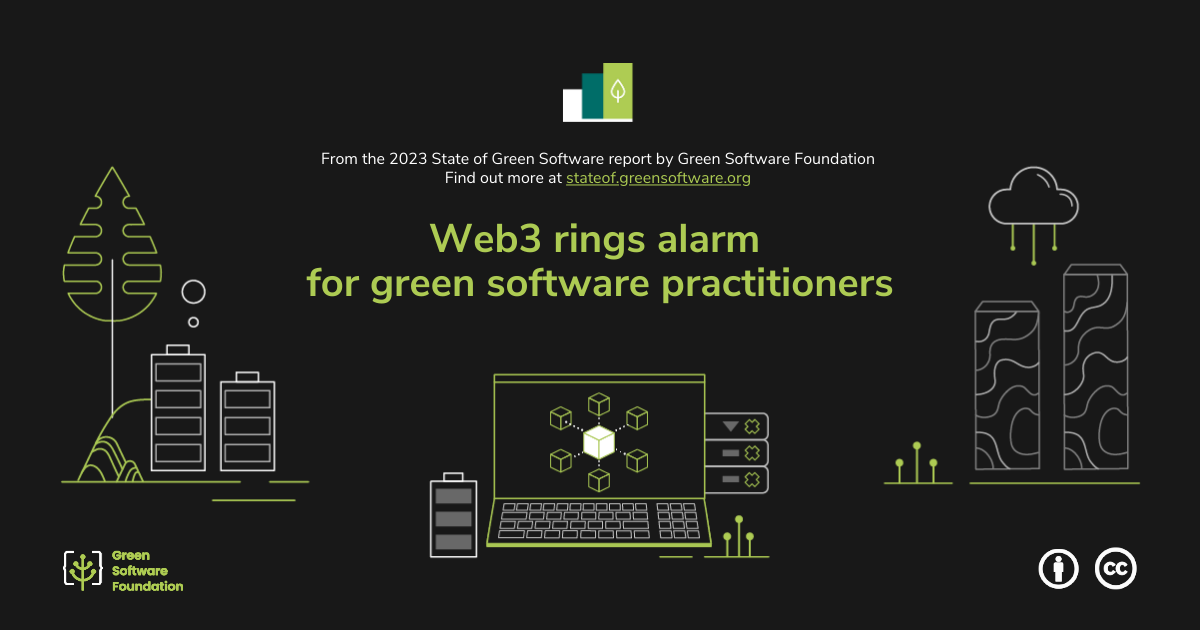Web3 rings alarm for green software practitioners
Let’s not forget that shortly before the rise of generative AI and the introduction of Chat GPT, Web3 was being hailed as the most important technology trend to watch. Many news reports and academic research articles focused on the carbon emissions tied to crypto mining, especially Bitcoin and pre-Merge Ethereum. A wave of legislation was introduced to limit crypto mining in some countries, including China, and brought forth new restrictions to some U.S. states, including New York. Standards organizations started exploring ways of measuring and reducing the carbon impact of blockchains. The Blockchain and Distributed Ledgers Committee of the IEEE Standards Association is working on a standard for blockchain in carbon trading. A Rocky Mountain Institute brief put forward principles for blockchain-based emissions, calling for “a standard, open-source, blockchain-based technical architecture that offers ways to share a cornerstone and become more comparable. We foresee a system in which every emission has its own ‘digital twin’ being originated at the source and flows through the supply chain attached to the commodities and then the products that are accountable for it. A ‘digital wallet’ for each product will represent its emissions, and the facilities receiving intermediary products will see a trace of the product emissions flowing through—which in aggregate represent the supply chain (scope 3) emissions associated with each entity in a supply chain. Digitizing emissions data and integrating it with existing procurement practices can serve as a cornerstone for any tracking system, exchange, or repository of information involving GHG disclosures.” Despite these regulations, standards interventions, and the overall crypto winter, crypto emissions are still climbing because of existing crypto infrastructure.
Many of the scandals plaguing crypto reveal broader problems with carbon offsets. Even with emergent standards and attempts at verification, carbon offsets are difficult to track over time and may do more harm than good. The Guardian reported that over 90% of carbon offsets are not accurate. According to research into projects certified by Verra, the leading carbon standard, “Only a handful of Verra’s rainforest projects showed evidence of deforestation reductions, according to two studies, with further analysis indicating that 94% of the credits had no benefit to the climate.” Many climate-focused Web3 projects used tokens to incentivize positive climate action, from planting trees to protecting the rainforest. But these projects, too, are often beset by unreliability and scandal. For example, environmental organizations accused the Brazilian company Moss of selling low-quality credits and not delivering on promises made to local communities. Carbon offsets are not a reliable solution to climate change, emphasizing the need for actual decarbonization efforts and an energy transition away from fossil fuels.
The effects of regulation and public perception on Web3 are a good entry point for understanding how carbon emissions tied to software is a potentially fraught and incredibly complex subject. Because of crypto’s well-known carbon emissions problem, Web3 practitioners think about climate impacts from the very start and are highly attuned to ESG compliance. Some Web3 practitioners view themselves as grassroots climate activists. They are interested in reducing the carbon emissions associated with blockchain technology while finding new ways of increasing supply chain transparency and making climate data more accessible through the blockchain. A report from Linux Foundation and Intel examines the various ways Web3 stakeholders, both from the Bitcoin mining and Ethereum or alternative blockchain communities, along with regulators, researchers, and standards bodies, are grappling with the environmental toll of blockchain. Some aspects of Web3 also intersect with other high-energy workloads, including gaming and virtual reality. So while crypto winter may be in full effect, the spirited discussions around carbon offsets and emissions in Web3 point to the need for collaborative, thoughtful approaches to decarbonization across the industry.
